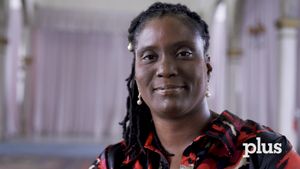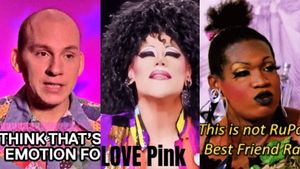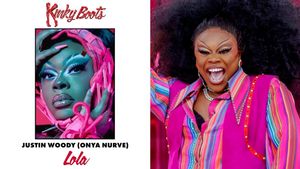In the 1980s the AIDS epidemic was treated as a top story on the nightly news in the U.S. and abroad. For gay men, it was a source of constant fear and anxiety, and it was also the focal point for activism within and outside our community. Because of this, medical researchers were pushed to do whatever it took to make the death toll drop. And in the late '90s, the world finally took a breath and gay men didn't have to worry about which friend's funeral they should attend after extremely effective antiretroviral medications came onto the market. Since then, HIV and AIDS have faded out of the limelight as other issues took precedent. But for gay men, as soon as HIV drifted from our worst nightmares it allowed other issues to become more important and HIV got a chance to make a comeback.
The pendulum really swung during the 2004 election, when the issue of same-sex marriage became the topic of conversation at every dinner table in America. I was sitting in my mother's living room, watching the results of the George Bush-John Kerry race slowly come in. Each update increased my feeling of defeat. Not only was President Bush staying in office for another term, but Texas, my home state, along with many other states, had passed a ban on gay marriage.
Out of the ashes of the 2004 election cycle came a relatively new dynamic, with clear heroes and villains to which both sides could cling. It was the "moral majority" versus gay families and their allies who had an eventual goal of full marriage equality.
On one side of the spectrum, Focus on the Family, a conservative evangelical Christian organization founded in 1977 by psychologist James Dobson gained a lot of traction around the 2004 election. Back then, he said the institution of marriage "is about to descend into a state of turmoil unlike any other in human history." Similar sentiments were echoed by many other evangelical organizations, and the threat of gays spreading their gay germs, so to speak, was now also overshadowed by the threat of same-sex hand-holding on top of a wedding cake. So instead of HIV, organizations like Focus on the Family became enemy number one for gay rights organizations.
Meanwhile, as marriage increasingly became a focus of the LGBT community, the rate of new HIV infections among gay and bisexual men has increased. The annual rate rose by a staggering 132.5 percent between 2001 and 2011, according to the Centers for Disease Control and Prevention.
To see the what happened, just take one look at the 2004 annual report from the Human Rights Campaign. In 12 pages, HIV is barely mentioned, and even in discussions around domestic-partner health insurance coverage, the issue of HIV among the gay population was completely absent.
But it wasn't just HRC that caused the LGBT movement to direct its attention away from HIV. After Proposition 8 was passed in California in 2008, revoking the right for same-sex couples to marry, movements such as the NoH8 campaign especially gained the attention of gay youth as well as allies.
For the whole of gay culture, this was a major step in the right direction. In battle after battle in the state and federal courts around the country, the same-sex marriage movement has been victorious. In 2013, the U.S. Supreme Court overturned most of the so-called Defense of Marriage Act, which helped change the tide in the court of public opinion. For the first time, the majority of Americans believe that LGBT people deserve equal rights, and many statewide and national organizations, including the HRC, have been marking off state after state for legalized same-sex marriage.
But these victories have come at a cost. When marriage became virtually the singular focus of the gay community, the virus received the break it needed to stage a comeback among gay and bisexual youth who were too busy fighting in courtrooms to worry about the bedroom.
Many older gay men shake their heads at the latest numbers showing the HIV rates of our young boys reaching sky-high levels. Why and how could these kids make such mistakes after countless friends and lovers died of AIDS complications? But to elude the blame would be quite hypocritical, since the older generation led the shift away from HIV education and prevention once the wedding bells started ringing.
Paradoxically, youth was a major focus for many LGBT organizations. The Trevor Project focuses on preventing suicide among LGBT youth and has the backing of multiple A-list celebrities, including Lady Gaga, Ellen DeGeneres, Katy Perry, and Neil Patrick Harris. The It Gets Better Project, a video movement with the mission to inspire LGBT youth, is an international phenomenon, with 50,000 user-created videos viewed more than 50 million times. Both organizations have made significant changes in how LGBT people are viewed in society and how gay youth deal with their sexuality. But there is a stark absence of HIV programming and messaging that a young, newly HIV-positive person can relate to.
Eight years after its 2004 report, HRC's 2012 document dedicated an entire page to the issue of LGBT youth. The organization highlighted the fact that more than half of LGBT youth say they have used alcohol and drugs while only 22 percent of non-LGBT youth say they have. They reported that LGBT youth are profoundly more disconnected than their straight peers from their families, schools, and communities. And the report claimed that non-LGBT youth are nearly two times as likely as LGBT youth to say they are happy. But starkly missing from the LGBT youth page is the fact that young gay and bisexual males make up 69 percent of new HIV infections among persons aged 13-29.
This is especially damning, as the CDC says, "Young MSM may be at risk because they have not always been reached by effective HIV interventions or prevention education -- especially because some sex education programs exclude information about sexual orientation."
Now, that sounds like a human rights issue that deserves some national attention.
Luckily, HRC has now partnered with Greater Than AIDS to release a comprehensive resource guide, which focuses on prevention and treatment for the LGBT community. And most recently, HRC president Chad Griffin has said the organization is taking on a bigger plate of issues that will serve the broader LGBT community. HRC is now leading the charge with other progressive organizations such as the San Francisco AIDS Foundation and the World Health Organization in recommending the use of Truvada as PrEP for people who are at risk for HIV infection.
In the end there is no one person or group of people responsible for the rise in infection; the entire community is liable for letting its guard down. But now we have an entire generation of young gay and bisexual youth who are completely under-prepared to battle an enemy that we know how to beat.
It would be great if HIV was over, and the LGBT media and activist movements could afford to skirt the HIV issue all together. But you are only as strong as your weakest player, and with a 132.5 percent increase in HIV infection, the team is looking pretty weak. Of course, there are organizations that focus solely on HIV prevention in youth, but every LGBT organization should commit to making HIV prevention a part of the discussion, especially for our youth.
Even though HRC and many other gay rights organizations have racked up trophies in the past decade, this number represents a glaring stain on our record. It is time to once again make ending HIV a top priority within the gay community. Gay marriage and equal rights are central to the progress of our community, but these victories aren't anything if some of our people are silently suffering from a preventable disease while others rush to the aisle.
TYLER CURRY is the senior editor of HIV Equal, a comprehensive online publication dedicated to promoting HIV awareness and combating HIV stigma. To learn more about HIV Equal, visit HIVequal.org or follow Tyler Curry on Facebook or Twitter @iamtylercurry. He was also named to HIV Plus magazine's list of 20 Amazing Men With HIV.


































































Charlie Kirk DID say stoning gay people was the 'perfect law' — and these other heinous quotes